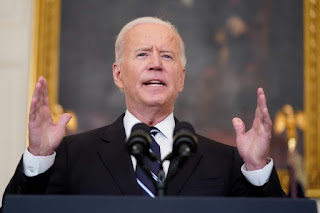US president Biden orders deployment of US troops in Poland, Romania and Germany
Nearly 2,000 US troops will be deployed from US to Germany and Poland while 1,000 troops redeployed from Germany to Romania
US President
Joe Biden ordered the deployment of nearly 3,000 troops in Eastern Europe. 2,000
U.S.-based troops will be deployed to Poland and Germany and 1,000 troops based
in Germany will move to Romania.
Of the 2,000
U.S. troops newly deploying from Fort Bragg, North Carolina, about 1,700 are
members of the 82nd Airborne Division infantry brigade, who will go to Poland.
The other 300 are with the 18th Airborne Corps and will go to Germany as what
the Pentagon called a “joint task force-capable headquarters.”
The 1,000
U.S. troops going to Romania are members of the 2nd Cavalry Regiment based at
Vilseck, Germany. They will augment about 900 already in Romania, Kirby said.
The cavalry
deployment’s purpose is to “deter aggression and enhance our defensive
capabilities in frontline allied states during this period of elevated risk,”
the Pentagon said in a separate written statement.
NATO has
been beefing up its defenses around allies in Eastern Europe since late last
year. Denmark, for example, said it was sending a frigate and F-16 warplanes to
Lithuania, and Spain was sending four fighter jets to Bulgaria and three ships
to the Black Sea to join NATO naval forces. The Netherlands plans to send two
F-35 fighter aircraft to Bulgaria in April and is putting a ship and land-based
units on standby for NATO’s Response Force.
Biden has
said he will not put American troops in Ukraine to fight any Russian incursion,
although the United States is supplying Ukraine with weapons to defend itself
and seeking to reassure allies in Eastern Europe that Washington will fulfill
its treaty obligation to defend them in the event they are attacked.
Pentagon
press secretary John Kirby said the soon-to-deploy U.S. forces are intended to
temporarily bolster U.S. and allied defensive positions. “These are not
permanent moves,” he said, stressing that the purpose is to reassure allies.
Kirby said Russia had continued its buildup, even in the previous 24 hours,
despite U.S. urgings that it deescalates.
The US is
accusing Russia that it preparing to invade Ukraine but Russia is refuting this
claim. The tension exists between Russia and US on the question of NATO
expansion in Eastern Europe. The US wants to include Ukraine and Georgia in the
US led military alliance. The Russia sees this expansion as a direct threat to
its national security and strategic interests in the region.
Russian
President Vladimir Putin also had a new telephone exchange with British Prime
Minister Boris Johnson. But readouts from both governments showed no progress,
with Putin saying the West was giving no ground on Russia’s security concerns
and Johnson expressing deep concern about Russia’s “hostile activity” on the
Ukrainian border, referring to Putin’s buildup of 100,000 troops there.
No U.S.
troops are being sent to Ukraine, and White House press secretary Jen Psaki on
Wednesday said the administration has stopped calling a Russian invasion
“imminent,” because that word implies Washington knows Putin has made a
decision to invade. Officials say Putin’s intentions remain unclear.
However, increasing U.S. troop levels in Eastern Europe is exactly what Putin has said he finds intolerable, along with the prospect of Ukraine joining NATO.
The U.S. already has several thousand troops in Poland, and Romania is host to a NATO missile defense system that Russia considers a threat. The U.S. presence in the region has increased since 2014 when Russia made its first invasion of Ukraine.In Moscow, a
senior official said the U.S. movements will complicate the crisis. “The
unfounded destructive steps will only fuel military tensions and narrow the
field for political decisions,” Deputy Foreign Minister Alexander Grushko said
in remarks carried by the Interfax news agency.
Ukraine’s
Foreign Minister Dmytro Kuleba again played down fears of a Russian attack in a
call with reporters but said that if Russia makes moves that could signal an
imminent invasion Ukraine would react as necessary.
The Pentagon
also has put about 8,500 U.S.-based troops on higher alert for possible
deployment to Europe as additional reassurance to allies, and officials have
indicated the possibility that additional units could be placed on higher alert
soon. The U.S. already has between 75,000 and 80,000 troops in Europe as
permanently stationed forces and as part of regular rotations in places such as
Poland.














Post a Comment